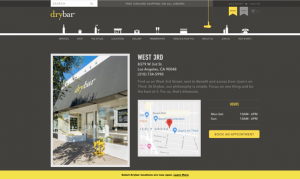The topic of “top-level domains” sounds like something out of the gaming world, doesn’t it? The phrase evokes something right out of a MMORPG (massively multiplayer online role-playing game) involving magic, enchantment, and a final battle between good and evil.
Intriguing? Yes. Reality? No. In truth, top-level domains (TLDs) are a bit less fantastical and a bit more everyday. They are the highest level in the hierarchical Domain Name System (DNS) of the Internet or more simply the rightmost letters after the dot in a web address. In www.google.com, for example, the “.com” is the top-level domain. The “google” is known as the second-level domain, and the “www” is known as the third-level domain.
 Was the top-level domain a consideration for your website?
Was the top-level domain a consideration for your website?
Sure, we all know the top-level domains of “.com,” “.org,” and “.net.” Perhaps when you couldn’t get the website domain you wanted, maybe you have even opted for a “.biz,” “.info,” or “.us.” But did you know that your options have multiplied dramatically? Is this something to take advantage of or not?
There are a lot of considerations when building a website. Make sure the choice of top-level domain isn’t forgotten in the mix.
The History of TLDs
The official list of Top Level Domains is maintained by the Internet Assigned Numbers Authority (IANA), a department of the Internet Corporation for Assigned Names and Numbers (ICANN), a non-profit that “promotes competition and develops policy on the Internet’s unique identifiers.” Their first release of domain names countered the less user-friendly Internet Protocol address (IP address), which is a string of numbers, such as “127.0.0.1.”
In the 1980s, the first seven TLDs released were “.com,” “.edu,” “.gov,” “.int,” “.mil,” “.net,” and “.org.” These were the only TLDs until seven more were introduced between 2001 and 2002. This second list included “.biz,” “.info,” “.name,” “.pro,” “.aero,” “.coop,” and “.museum”—the latter three of which are sponsored top-level domains similar to “.edu,” “.gov,” “.int,” “.mil,” and (formerly) “.org,” meaning that these exist for a closed community.
Of course, many new top-level domains have arisen since the early ‘00s. The most recent release was in February of 2014. However, 2014 also had another new development in the world of top-level domains. Business owners can also now apply for a new custom TLD. As a result, nearly 1000 TLDs are presently in use, and this number is only growing.
Top-Level Domain Statistics
According to W3Techs.com, as of April 30, 2015, domains ending in “.com” made up 51.4% of all websites; “.net” made up 5.1%, and “.org” followed shortly behind at 4.1%.
Countries that have embraced the internet can easily be gauged by examining other popular top level domains. For example, the most popular country codes are “.ru” (the Russian Federation) at 4.8% of websites, “.de” (Germany) at 2.0%, “.uk” (United Kingdom) at 2.0%, “.br” (Brazil) at 2.0%, and “.jp” (Japan) at 2.0%. In total over 250 two-lettered country codes have been registered as TLDs.
If you’re curious about other well-known top-level domains, their presence is as follows:
- “.info” – 1.1%
- “.biz” – 0.7%
- “.co” – 0.4%
- “.us” – 0.3%
- “.me” – 0.3%
- “.edu” – 0.1%
- “.mobi” – 0.1%
Choosing a TLD for Your Business
When 2014 saw the release of so many new top-level domains, the internet was abuzz with the idea that the personalization and specificity now available would change the marketing world. Why not own a short domain name that’s easy to include on marketing materials and exactly the second-level domain that best represents your company?
Is the cool factor there? Sure. However, there are other elements to consider when choosing the website that will represent who you are.
- There’s a level of trustworthiness in a “.com” that can make many audiences think a business is more legitimate. Websites ending in “.org” often imply a similar degree of dependability. This is by no means a black and white line, but there is something to be said for a comfort level with the familiar. Times are early yet with new domains, of course.
- Having a “vanity TLD” tells audiences that your website is new. No matter how established your business, if your website screams that it was launched in 2014 or 2015, again, your reputation can appear unproven.
- When people don’t remember a website name, they often add in “.com” as an assumption.
- Similarly, a top-level domains like “.co” is often typed incorrectly, assuming the “.com.”
- There is no SEO benefit to owning either an industry specific TLD or a well-established TLD. For example, www.johndoe.realtor would have no advantage in Google’s search engine results page (SERP) algorithm over www.johndoe.com and vice versa.
So does that make “.com” the definitive answer for your business? Maybe, maybe not. There’s a lot to consider, and the technology world (and its audience) is evolving rapidly. However, the decision needs to at least be an informed one.
We will say that TLDs such as “.ninja,” “.fail,” and “.wtf” might not scream professionalism. Yes, these are examples of new top level domains as of February 2014. What is the world coming to, you may ask? Of that, we’re unsure, but at least we’re speaking of the real world here, not one of supernatural conquest. No wizards or elves, no ogres or dark knights. Or at least, we don’t believe so.
(232)







